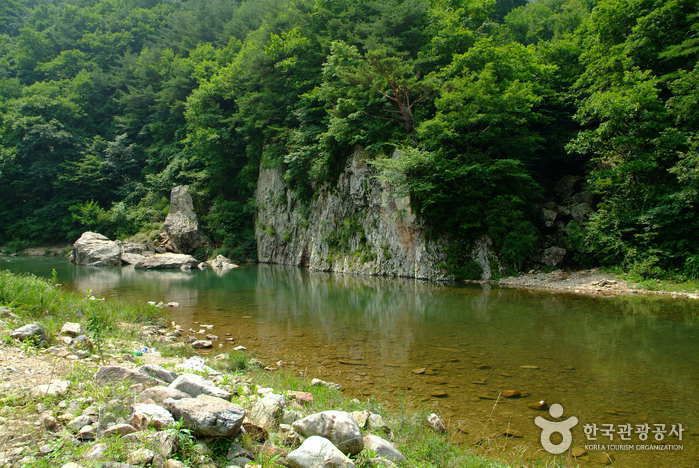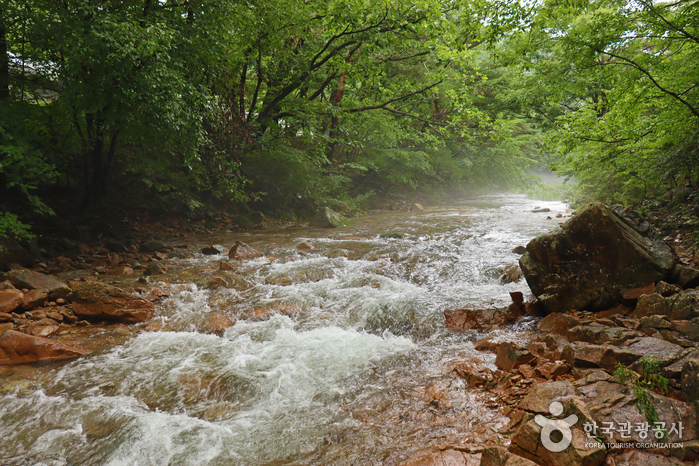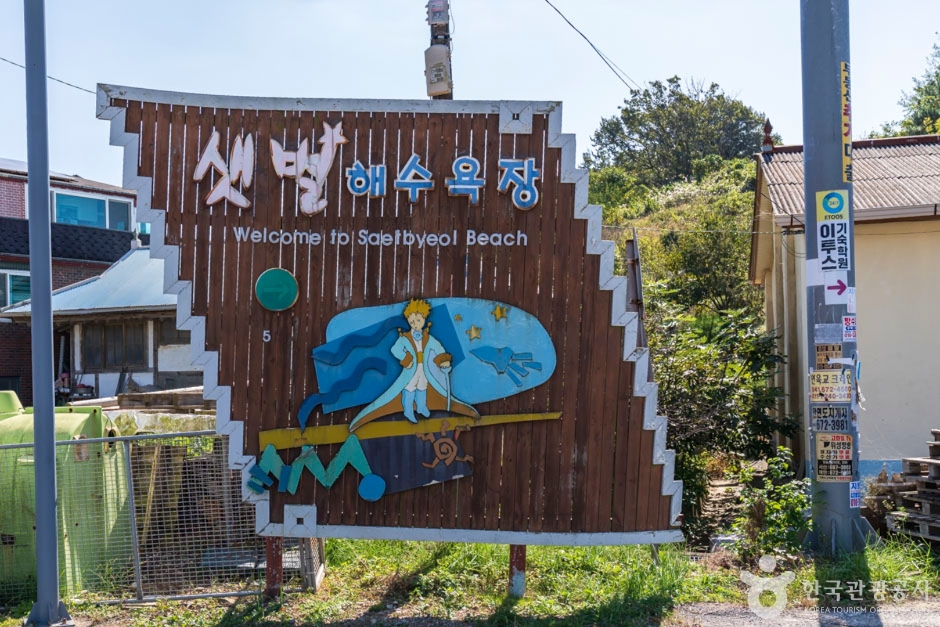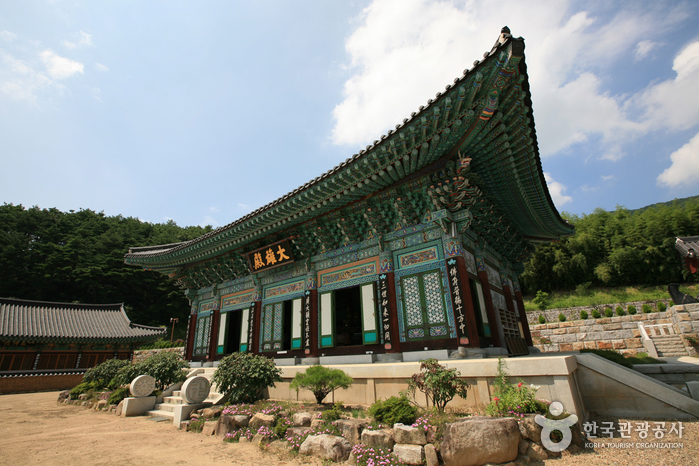Seowongyegok Valley (서원계곡)
2024-02-26
491-4, Jangan-ro, Jangan-myeon, Boeun-gun, Chungcheongbuk-do
Seowongyegok Valley is fed by the Samgacheon Stream, which originates from Songnisan Mountain and flows through Samga Reservoir in an S-shaped curve. It is relatively gentle in slope, and the stream is quite wide. The area is home to the 600-year-old Seowon-ri Pine Tree. Aside from enjoying the beautiful view of the area, one can also swim in the valley in summer.
Mansugyegok Valley (만수계곡)
2025-01-17
136, Mansu-gil, Songnisan-myeon, Boeun-gun, Chungcheongbuk-do
Mansugyegok Valley is a 4 km-long valley fed by the Samgacheon Stream, which originates from Cheonwangbong Peak in Songnisan Mountain and flows into Samga Reservoir. Its name refers to how it has enjoyed tens of thousands of years of age. Its clear water and lush forests make it a popular summer and forest bath destination. The summit of the Songnisan Mountain can be reached along the valley. There’s also a trail that leads to the Beopjusa Temple of Songnisan Mountain.
Saetbyeol Beach (샛별해수욕장)
2024-02-26
184-2 Saetbyeol-gil, Anmyeon-eup, Taean-gun, Chungcheongnam-do
Saetbyeol Beach is situated on the western side of Anmyeondo Island. It features a balanced mix of sand and pebbles, offering a stunning view of the Yellow Sea and distant islands. Additionally, a glamping campground and nearby pensions provide accommodation options, allowing visitors to enjoy the scenic beauty of Korea's rural villages and fields.
Buinsa Temple (Daegu) (부인사(대구))
2024-02-23
967-28 Palgongsan-ro, Dong-gu, Daegu
Buinsa Temple is a temple nestled on the southern slopes of Palgongsan Mountain, with a deep historical connection to Queen Seondeok of Silla (580–647). The temple is renowned for preserving the woodblocks of the First Tripitaka Koreana, a collection of Buddhist scriptures carved in the 11th century. The current Buinsa Temple encompasses significant structures, including Daeungjeon Hall, Queen Seondeok's Memorial Hall, and Samseonggak Shrine. Visitors have the opportunity to appreciate the scenic beauty of nature while exploring the cultural and architectural heritage from the Silla and Goryeo periods.
Nangchugol Learning Park (낭추골 현장체험학습원)
2025-01-17
1890 Danjae-ro, Nangseong-myeon, Sangdang-gu, Cheongju-si, Chungcheongbuk-do
Nangchugol is a mountain village located in the eastern part of Cheongju, offering children the chance to observe and experience nature through play and a variety of activities. It boasts a goblin trail, four-season sledding options (grass sled, water sled, and snow sled), swimming pools, a nature learning center focusing on wild plants, valleys, and animals, a traditional game ground, an adventure playground, an insect experience center, and guided forest tours. Additionally, the village includes a campground for visitors.
Uihang Beach (의항해수욕장)
2024-02-26
Uihang-ri, Sowon-myeon, Taean-gun, Chungcheongnam-do
Uihang Beach, situated in Taean, gets its name from "Uihang," meaning the neck of an ant, alluding to the area's narrow and elongated terrain. The beach features a gentle slope with both sands and pebbles. Fishing is available on the breakwater, and the vicinity offers various accommodations, including a campground, pensions, lodgings, and a hanok resort.
Gubyeongsan Mountain (구병산)
2024-02-26
Jeogam-ri, Maro-myeon, Boeun-gun, Chungcheongbuk-do
Gubyeongsan Mountain is an 876 m-high mountain located on the southern side of Songnisan National Park. It is also known as "Gubongsan Mountain" because it is said to have nine (gu) peaks (bong). There is a lush forest with plenty of beautiful rocky cliffs. Visit in the fall to enjoy the true beauty of the place. Boeun’s basin geographical feature can be seen from the summit.
The Peace Land (평화랜드)
2024-02-23
148-33 Imjingak-ro, Munsan-eup, Paju-si, Gyeonggi-do
The Peace Land is an amusement park located near the Imjingang River. It offers around twenty different types of rides, including a Viking ship, bumper cars, and merry-go-round. For added convenience, there is an unmanned convenience store on-site that accepts card payments exclusively, offering a variety of beverages, ice cream, and snacks. The park also has an infirmary where wound care is available. Nearby, visitors can enjoy the Peace Gondola, which provides a scenic way to cross the Imjingang River.
Samgaksan Mountain (삼각산)
2024-03-20
Samyang-ro 173-gil, Gangbuk-gu, Seoul
Samgaksan Mountain is a mountain situated on the northern outskirts of Seoul, resembling a folding screen. Its name, meaning triangular mountain, is derived from the presence of three high peaks: Baegundae Peak, Insubong Peak, and Mangyeongdae Overlook. The highest peak, Baegundae Peak, offers a panoramic view of Seoul from its summit, featuring a spacious rock surface where many visitors can sit. Positioned behind Gyeongbokgung Palace, the palace of the Joseon dynasty, Samgaksan Mountain is visible from the rear of the Cheong Wa Dae.
Cheonjangho Suspension Bridge (천장호 출렁다리)
2024-02-23
24 Cheonjangho-gil, Jeongsan-myeon, Cheongyang-gun, Chungcheongnam-do
Built in 2009, this emblematic suspension bridge of Cheongyang stretches a total of 207 meters. Its most striking feature is a 16-meter-high main tower in the middle, ingeniously crafted to resemble Goji berries and red peppers, Cheongyang’s proud local produce. Below it is a narrow 1.5-meter-wide, 20-meter-long bridge, which starts to sway subtly both vertically and horizontally, offering a gentle thrill to whoever walks on it. This bridge is engineered to swing up to 30 to 40 centimeters, adding to the excitement of the crossing. Upon reaching the other side, visitors are greeted by an observatory and a trail leading up to Chilgapsan Mountain. For those who prefer a less strenuous journey, a leisurely stroll around Cheonjangho Lake towards Hwangnyongjeong Pavilion is a delightful alternative. The lake, overarched by the suspension bridge and nestled at the foot of Chilgapsan Mountain’s eastern reaches, presents a spectacular vista, rightfully counted among Cheongyang's most celebrated sights. The hiking trail ascends to the top of Chilgapsan Mountain, offering yet another perspective to appreciate the beauty of Cheonjangho Lake, the Cheonjangho Suspension Bridge, verdant forests, and charming valleys. An especially unique experience is visiting the Cheonjangho Suspension Bridge at night when it’s aglow, revealing a mesmerizing nocturnal allure.





 English
English
 한국어
한국어 日本語
日本語 中文(简体)
中文(简体) Deutsch
Deutsch Français
Français Español
Español Русский
Русский